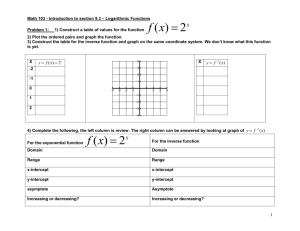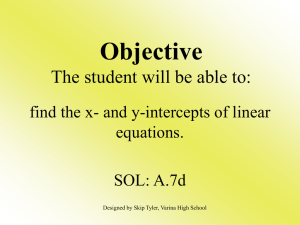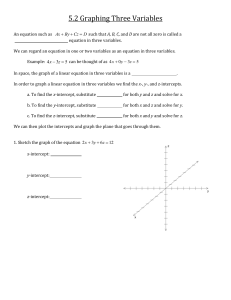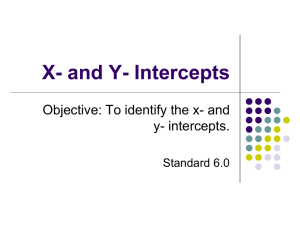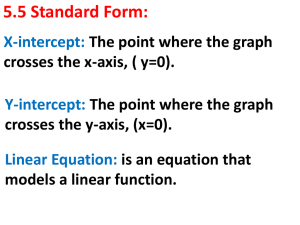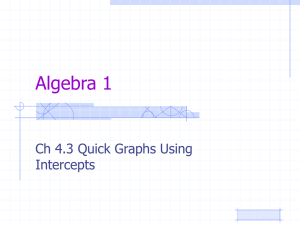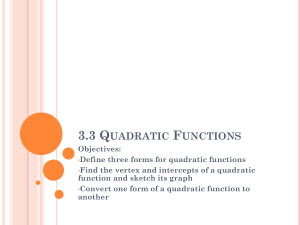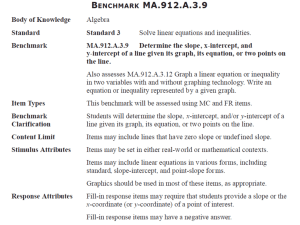Lesson 3.3 Linear Functions
advertisement
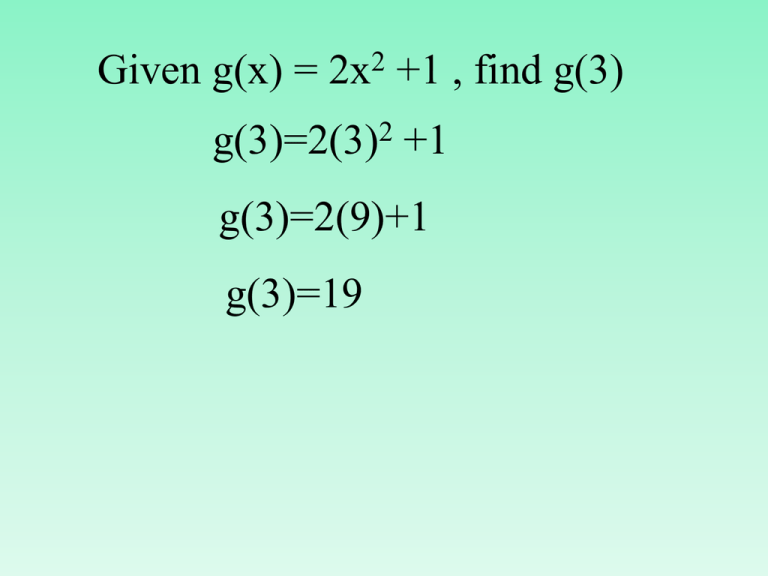
Given g(x) = 2x2 +1 , find g(3)
g(3)=2(3)2 +1
g(3)=2(9)+1
g(3)=19
Given f(x) = 3x - 1, find 4[f(4) – f(2)]
Given h(x) = 5+5x, find [f(4) – f(1)](-2)
3.3 Linear Functions
The student will be able to:
1. identify linear functions.
2. write equations in standard form.
3. Graph linear functions.
Indicators:
Designed by Skip Tyler, Varina High School
Vocabularies
• A linear equation is the equation of a line.
• An x-intercept is a point on the graph where y is
zero. In other words, an x-intercept is a point in
the equation where the y-value is zero.
• A y-intercept is a point on the graph where x is
zero. In other words, a y-intercept is a point in the
equation where the x-value is zero.
• Values of x for which f(x)=0 are called zeros. For
a linear function, the zero is its x-intercept.
Standard Form
Ax + By = C
A, B, and C have to be integers
An equation is LINEAR (the graph
is a straight line) if it can be written
in standard form.
This form is useful for graphing
(later on…).
Determine whether each equation is
a linear equation.
1) 4x = 7 + 2y
Can you write this in the form
Ax + By = C?
4x - 2y = 7
A = 4, B = -2, C = 7
This is linear!
Determine whether each equation is
a linear equation.
2) 2x2 - y = 7
Can you write it in standard form?
NO - it has an exponent!
Not linear
3) x = 12
x + 0y = 12
A = 1, B = 0, C = 12
Linear
Here’s the cheat sheet! An equation that is
linear does NOT contain the following:
1. Variables in the denominator
3
y 2
x
2. Variables with exponents
y x 3
2
3. Variables multiplied with other
variables.
xy = 12
Is this equation linear?
x 4y 3
1. Yes
2. No
Standard Form
x – 4y = 3
Is this equation linear?
2
9 4y x
1. Yes
2. No
Exponents are
not allowed!
Is this equation linear?
y = -3
1. Yes
2. No
Standard Form
0x + y = -3
Review of the definition.
• An x-intercept is a point on the graph where y
is zero. In other words, an x-intercept is a point
in the equation where the y-value is zero.
• A y-intercept is a point on the graph where x
is zero. In other words, a y-intercept is a point
in the equation where the x-value is zero.
• Values of x for which f(x)=0 are called zeros.
For a linear function, the zero is its x-intercept.
Determine the x-intercept, y-intercept,
and zero of the linear equation y=10x-1.
x-intercept:
•Set y=0
•Solve for x
0=10x-1
+1 +1
1=10x
x=1/10
y-intercept:
•Set x=0
•Solve for y
y=10(0)-1
y=-1
Determine the x-intercept, y-intercept,
and zero of the linear equation
y=10x-1.
x-intercept:
y-intercept:
Find the x-intercept, y-intercept,
and zero for the graph of the line.
Solution:
The x-intercept of this graph is 4.
The coordinates of the point at the
x-intercept is (4, 0).
The y-intercept of this graph is 2.
The coordinates of the point at the
y-intercept is (0, 2).
Find the x-intercept, y-intercept, and
zero for the graph of the line.
x-intercept: -3
y-intercept: 3
zero: 3
Work on the following problems:
• P 158 #3, 12-19 all,
Graph an equation by making a
table
Graphing Steps
1) Isolate the variable (solve for y).
2) Make a t-table. If the domain is
not given, pick your own values.
3) Plot the points on a graph.
4) Connect the points.
1) Review: Solve for y
1. Draw “the river”
2. Subtract 2x from
both sides
2) Solve for y:
1.
2.
3.
4.
2x + y = 4
- 2x
- 2x
y = -2x + 4
4x + 2y = -6
- 4x
- 4x
Subtract 4x
2y = -4x - 6
Simplify
Divide both sides by 2
2
2
Simplify
y = -2x - 3
3) Solve for y:
x - 3y = 6
x
x
Subtract x
Simplify
-3y = -x + 6
Divide both sides by -3
-3
-3
1.
2.
3.
4. Simplify
x 6
y
3
or
x
y 2
3
4) Review: Make a t-table
If f(x) = 2x + 4, complete a table
using the domain {-2, -1, 0, 1, 2}.
x
-2
-1
0
1
2
f(x)
ordered pair
2(-2) + 4 = 0
(-2, 0)
2(-1) + 4 = 2
(-1, 2)
2(0) + 4 = 4
(0, 4)
2(1) + 4 = 6
(1, 6)
2(2) + 4 = 8
(2, 8)
5) Given the domain {-2, -1, 0, 1, 2},
graph 3x + y = 6
1. Solve for y:
Subtract 3x
2. Make a table
x -3x + 6
-2 -3(-2) + 6 = 12
-1 -3(-1) + 6 = 9
0
-3(0) + 6 = 6
1
-3(1) + 6 = 3
2
-3(2) + 6 = 0
3x + y = 6
- 3x
- 3x
y = -3x + 6
ordered pair
(-2, 12)
(-1, 9)
(0, 6)
(1, 3)
(2, 0)
5) Given the domain {-2, -1, 0, 1, 2},
graph 3x + y = 6
3. Plot the points
(-2,12), (-1,9), (0,6), (1,3),
(2,0)
4. Connect the points.
Bonus questions!
What is the x-intercept?
(2, 0)
What is the y-intercept?
(0, 6)
Does the line increase or decrease?
Decrease
5) Given the domain {-2, -1, 0, 1, 2},
graph 4x + 2y = 6
Which is the graph of y = x – 4?
1.
2.
3.
4.
.
.
.
.
• P 158 36-37, 39-43 odds ( might change due
to time consuming)

